1966 Cadillac Coupe DeVille: Gorgeous in Gold!

Today’s question for all of you fine folks: What year was Peak Cadillac? What was the best possible year for the highest quality, most beautiful, most powerful version of GM’s storied top-of-the-line marque? Depending on the day, I might say 1962, 1968, or 1970. But today, I’m making the case for 1966. That year, Cadillacs—from most basic Calais to the top-of-the-line Fleetwood Brougham and Eldorado convertible—were swank, classy, and elegant. Any country club, fine hotel, or upper-tier department store would have been happy to have one parked right in front of their establishment.

Perhaps my affection for 1966 Cadillacs was reinforced because around the time I saw this most excellent example, I had recently gone out to the local theater and saw Once Upon a Time in Hollywood. I highly enjoyed it. Naturally, all the car spotting was a substantial part of my pleasure, and the “hero car,” driven by Brad Pitt through much of the movie, was a 1966 Cadillac Coupe de Ville.

Through pure good luck, or just decent odds due to all the car shows I attend, I saw a most excellent ’66 Coupe de Ville a mere week prior to screening the film. I’ve always loved Cadillacs, Lincolns, and Imperials. And although I drive Lincolns, I equally love seeing Cadillacs, especially the classic 1960s models.

There I was, wandering around with my Uncle Dave at the monthly cruise-in held by the local Classy Chassy (yes, that’s how they spell it) Car Club at Coral Ridge Mall in Coralville, Iowa. I’d just finished checking out a very nice 1972 Pontiac LeMans coupe when it appeared out of the ether—or just one of the mall entrances.

“Holy cow! That’s a nice ’66!” I stammered, hurriedly abandoning my uncle and my cousin Sara’s husband to chase after the Caddy. Yes, cars like this have that effect on me.
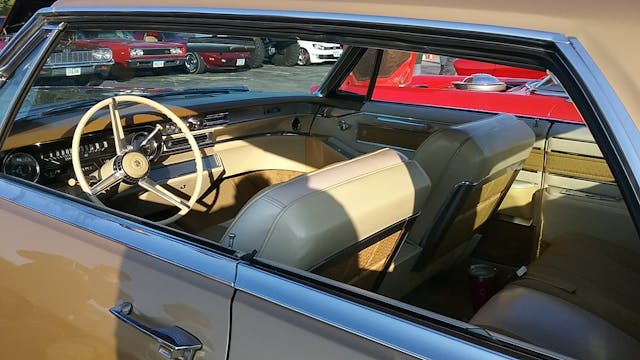
Ever notice the preponderance of red muscle cars, pony cars, and hot rods? I see so many. And I’m sure their owners love them, enjoy them, and never regret for one second getting them. But oh, how I love the offbeat stuff. I’ll march past a row of Mustangs and Camaros to gawk at an AMC Pacer Limited wagon, a 1977 Malibu Classic, or a 1979 Bonneville.
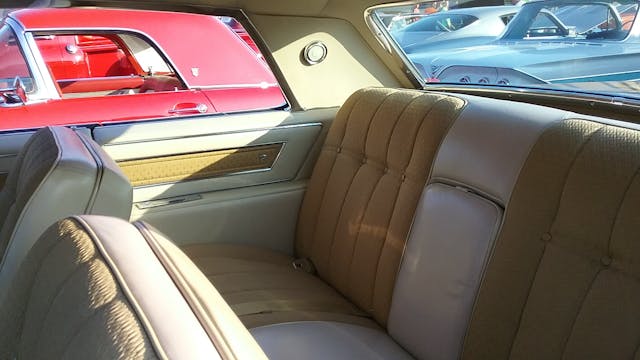
Stuff that was once commonplace in 1968 or 1978 or 1991 is now rare, unusual, and interesting. And if it’s a Chris-Craft-sized road vessel from the good ol’ United States, forget everything else, I’m checking it out immediately!

Now, where was I? Oh, yes. The cover of the 1966 Cadillac showroom brochure had the tagline “New elegance … new excellence … new excitement.” And so it was.

Cadillac had been all-new in 1965, so the 1966 models were not drastically different. But to my eye, all the minor details and refinements made for an even more beautiful car.

The ’66s were introduced on October 14, 1965. Color-keyed bezels replaced all-chrome units, there was a new grille and parking lamps, plus a revised tail treatment as well. New wheel covers, new colors and upholsteries, and even more refined trim and details rounded out all that was new this year. Heated seats and vario-ratio power steering appeared for the first time.

Series 683, better known as the de Ville series, was offered in four body styles: The Sedan de Ville, Hardtop Sedan de Ville, convertible, and the unforgettable Coupe de Ville. Really, is there a better car name than Coupe de Ville? Well, Imperial and Continental are contenders too, but I love the name of Cadillac’s luxury two-door hardtop.
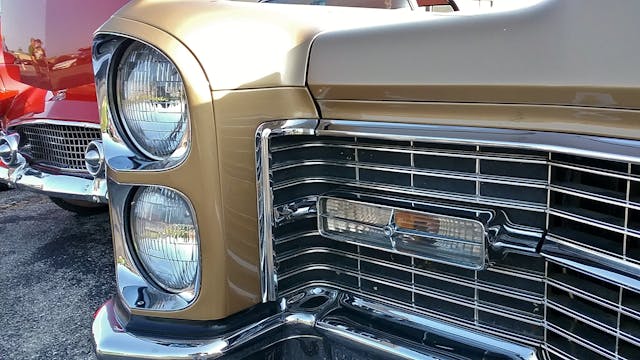
The 1966 Coupe de Ville, model #66-683, weighed in at a princely 4460 pounds and had a base price of $5339 ($49,738 today). A total of 50,580 were built for the year. This was no small amount. But when you bought a Cadillac, you GOT a Cadillac, and all that the name implied: Comfort, prestige, class, and luxury, naturally.

For comparison’s sake, that same year you could have picked up a new 1966 Chevrolet Caprice two-door hardtop for $3000 ($27,948) or a Buick Electra 225 Custom two-door hardtop for $4211 ($39,229). But in 1966, Cadillac was king of the domestic luxury cars.
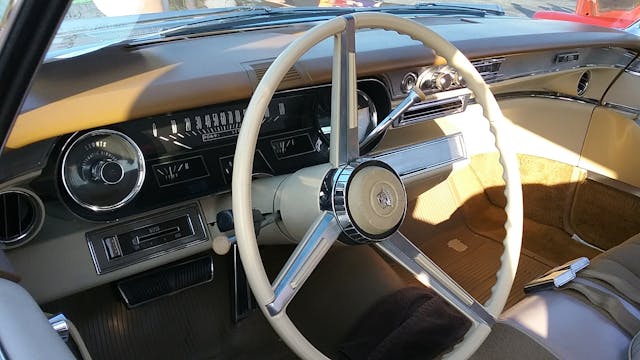
Sure, the Continental and Imperial were equally nice, luxurious conveyances, but Cadillac stood head and shoulders above them when it came to total sales. When you had a Cadillac, in 1966 America, you truly had arrived.

The Coupe de Ville, like all Cadillacs, was powered by a V-8. In 1966, it was a 429-cubic-inch bent eight with overhead valves and 4.13 x 4.0 bore and stroke, producing 340 horsepower at 4600 rpm. Breathing was accomplished via a Carter Model 3903S four-barrel carburetor.

It was backed up by the creamy smooth Turbo Hydra-Matic automatic transmission, with torque converter and a variable stator—though Seventy-Fives didn’t get that last feature, according to my 1966 brochure. Other major standard equipment on all Cadillacs included power brakes, power steering, and a heater/defroster. Automatic level control was standard on Eldorado, Sixty Special, Brougham, and all Seventy-Five models.

And you will be relieved to know all 1966 Cadillacs came with whitewall tires as standard equipment. Even the spare tire was a whitewall—a nice touch of class.

Coupe de Villes, naturally, were truly full-sized automobiles. Wheelbase was 129.5 inches, and overall length was an impressive 224.2 inches. With the sleek, squared-off styling that all 1966 Cadillacs displayed, they looked even longer than they actually were.

And of course, even if you bought a totally standard, zero-option Coupe de Ville, you still had a marvelous conveyance. If you wanted more (and many did—after all, it’s a Cadillac!), many optional extras were available if your wallet could handle it. For those folks of a certain age, some of these options may seem odd, considering you can get a 2019 Fusion or Malibu with them fitted as standard, but it was a different time.

How so? Well, here’s just a sampling of 1966 Cadillac factory options. Air conditioning was a substantial $624, or more than 10 percent of the base price of a 1966 Coupe de Ville. Other popular options included cruise control for $97, tinted glass for $52, leather trim for $151, and an AM/FM radio for $191. The previously-mentioned heated front seat retailed for $60.20, and bucket seats with center console (with mandatory leather trim) were $188.

But for those folks splurging on a brand new Cadillac, such finery was expected, and buyers happily added whatever they wanted. And they drove out of the dealership happy, with zero regrets.

Our featured car was resplendent in Antique Gold, with cloth and leather interior trim in gold and white. It was a stunning example. As gorgeous in 2019 as it must have been sitting in the showroom in Autumn of 1965. As Cadillac advertising 20 years later often said, “Best of all … it’s a Cadillac.” And was 1966 Peak Cadillac? Perhaps. It’s certainly a contender!
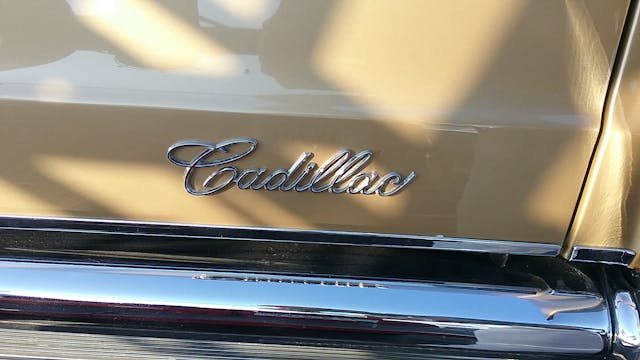
***
Check out the Hagerty Media homepage so you don’t miss a single story, or better yet, bookmark it. To get our best stories delivered right to your inbox, subscribe to our newsletters.
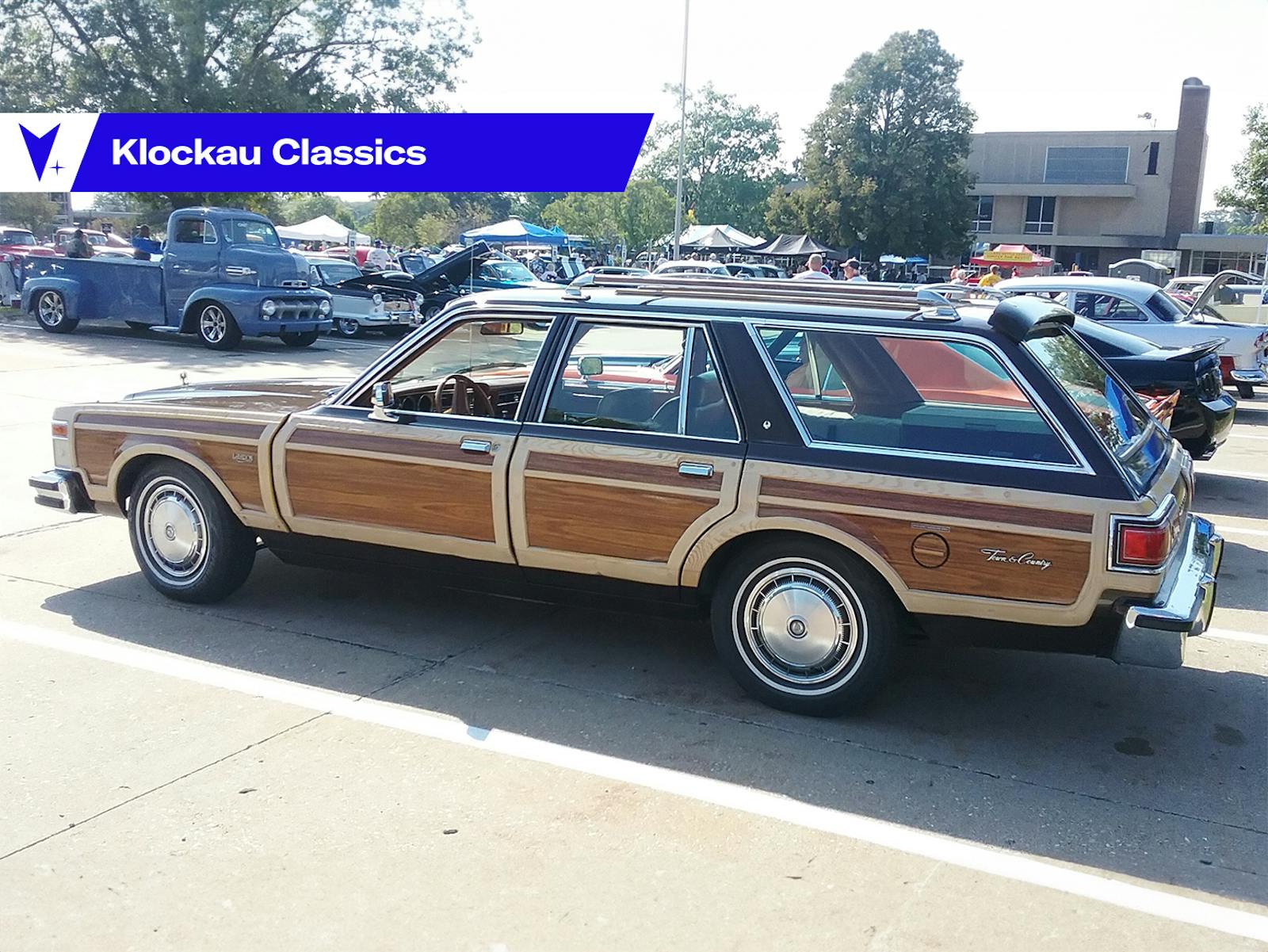
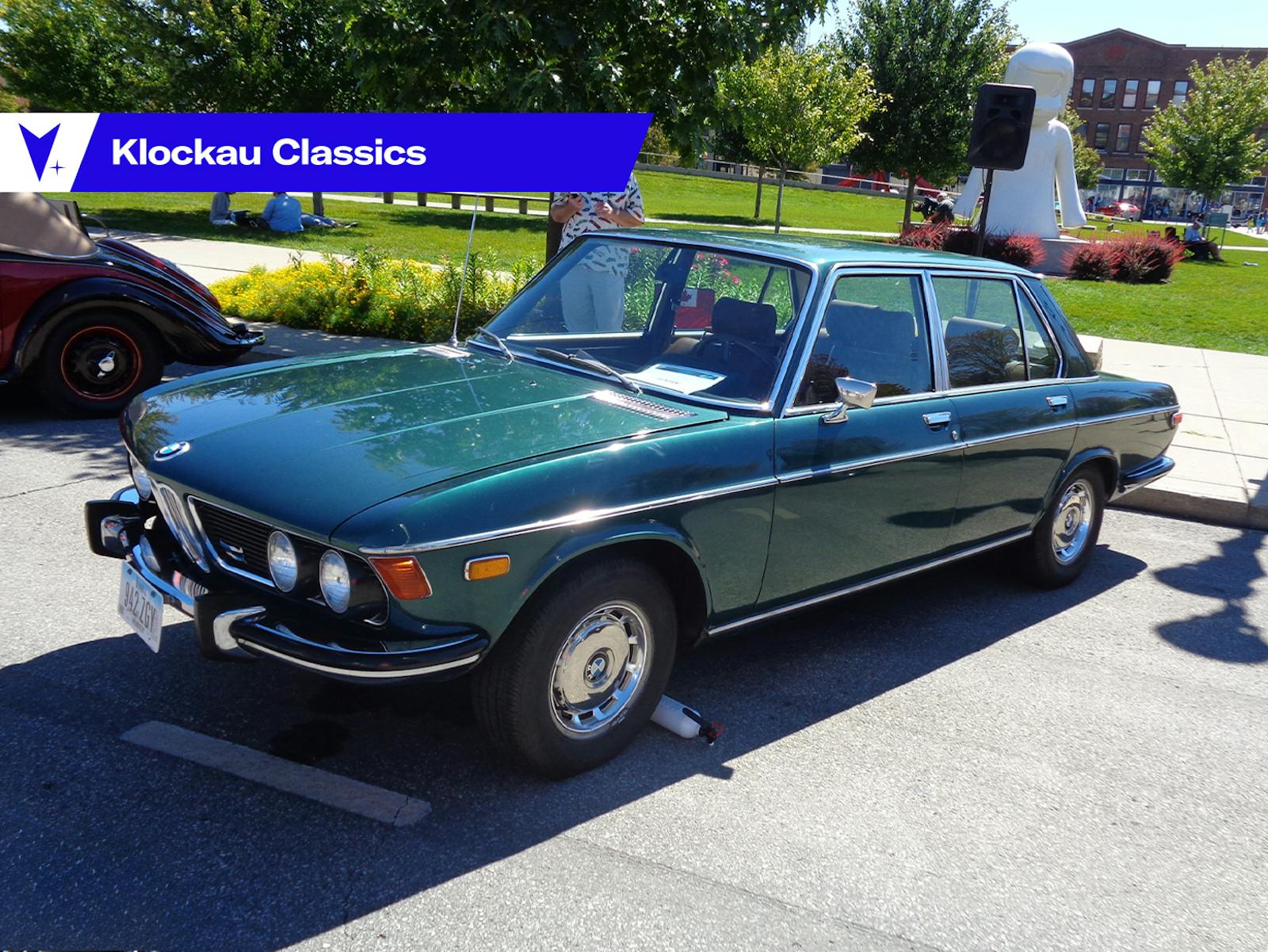
I’d say that a case could be made that any Cadillac between 1954 and 1970 was “peak Cadillac”. They were all outstanding, especially compared to the competition.
My personal favorite would be a 67-68 ElDorado, but again, a case could be made for any of that time period.
The fall of Cadillac has been many decades in the making, and it’s a sad story. Hagerty should write that story, but they probably won’t.
My thought is the 61 coupe Deville was the best motored with fin styles
My father had a ’61 coup, that was some vehicle.
Last quality year for gm across the board was 67. From 68 on, all interior metal was replaced with plastic and… The side vents for the front windows were eliminated. GM called it style… It was a savings of $73 per unit.
Tom, nice example of a 66 CDV. There is a typo in the series numbers you list numbers was left off in editing.
The SDV hardtop (no B pillar) was 66-68339
The CDV (like your example) 66-68357
The DVC (convertible) 66-68367
The SDV (with B pillar) 66-69369
And no I did not know that off the top of my head, I had to check the CLC directory. 🙂 🙂
Yes, the fall of Cadillac is indeed a sad story; I saw a new one on the street yesterday and din’t know whether to laugh or cry…these mid-60’s models were not only beautiful, but what a ride! Nothing on the road today rides like the American luxury cars of that era. The so-called experts who have continually panned them for having no road feel and poor handling just don’t get it. It’s a LUXURY car, folks. If I want handling and road feel I’ll drive something else. Quiet, isolation, comfort and class was what driving or riding in one of these was all about. A wonderful era for the automobile (and so much else for that matter) gone forever.
Cadillac’s are beautiful fine running cars
Yes I have a deville
I well-agree with the comments. I had, in ownership order: a 1970 CdV, a 1967 CdV convertible, and a 1957 SdV.
All were wonderful cars and, for their size, were surprisingly quick. I still miss them, frequently dreaming about them.
These days—a 2002 DeVille.
I would say for interior quality, fit and finish, 1964 was the last of well assembled high quality built interiors that still had a little of that late 50’s vibe to it. Last of the nicely finished chrome/satin steering wheel too with the beautiful Cadillac emblem crest in gold.
The grills of the 63-64’s which are very similar to the 1960 model just very toned down, are also very nice Cadillacs.
I used to own a ’68 Cadillac Coupe Deville, and although it was a wonderful performing car with the massive 472 engine that looks similar to the ’66, it’s interior quality is nowhere near as nice looking or feeling like how the earlier 60’s Cadillacs were. Too much plastic and vinyl trimmings on the inside compared to real metal chrome finishes and metal dashboards of the earlier years.
But by 1969, Cadillacs interiors hit a low point. The dashboard is truly horrendous looking and cheaply made including the door panels, the seats were mighty comfortable however.
For ultimate high-quality trimmings inside and out, stylistically, and construction wise, pretty much all the Cadillac’s built in the 1950’s were truly the golden era of Cadillac. So much detail, thick heavy chrome pieces everywhere, the grilles alone on some years looked to be extremely expensive to build and the styling was the best IMO out of all of the decades. They all just look so expensive in the way they were designed and constructed.
The 57-58 Eldorados were special cars, including all the Fleetwood 60 Specials from the 50’s, all of the Cadillac convertibles during that time were downright drop dead gorgeous, the heavy bold looking Cads from 1950-56 with the massive dagmar bullet “bomb” bumpers were simply awesome! You could literally sit on one of those bullets they are so large and could probably crush anything in its way. 2 tone exteriors and interiors was all the rage. The late 50’s Cads became lower, sleeker, slimmer but definitely more flamboyant and exciting. The 58-59’s being the coolest ones.
You could even go back to Cadillacs made in the 1920’s-1940’s, they were all nice well constructed cars, but the 50’s Cads are nicer to drive and handle on modern roadways having power steering, power brakes, more powerful 331-365-390 engines and the stout hydramatic trans made cruising in 50’s Caddy’s truly an enjoyable experience. They are classy n elegant works of art.
I love 60’s Cadillacs too, but when compared to the 50’s, the 50’s Cads blew away almost everything on the road in its day from a styling standpoint. I also enjoy the taller roofline Cadillacs up until 1956 as they are very easy to get in and out of and had the much more overall interior space, than any 60’s Cadillac I have ever driven.
Regardless of some cheapness and plastics during the late 60’s, I do like Cadillacs up until 1970. That year was truly the last of the high-performance Cadillac with bulletproof reliability. The 472-TH400 combo is a match made in heaven. Still great styling especially with that grill and better build quality vs the “rattley” 1971-73 models which were truly poorly put together.
Though I love Lincolns, ‘60s Cadillacs are my favorite. I especially love the ‘66 and ‘67 Fleetwood Broughams. Yes, the interiors of the the earlier Caddys were still luxurious and of good quality. We have had seven 2000s Cadillacs and you might as well be driving a Chevy. Rough ride, crappy interior finish and tons of road noise.
Finally went back to Lincolns and so glad we did, but even they are not up to the quality of old.
After ’67… It’s all plastic across the board for everything G.M.
I’ve got a 1970 Coupe with the same colors, I call her Peanut Butter and White Bread!
I own 2 caddy’s one is a 1988 eldorado biarritz and the other is a 2003 deville. They both are excellent cars and gets alot of compliments on them both.
My grandfather bought a new 1950 gray sedan the year I was born. He bought another new sedan in 1955, dark green over light green two tone. Though he could well afford a new car on a more frequent basis, he waited until 1959 to replace the ’55. It was pure white with the sloping roofline and I remember wishing he’d waited just a few more months to get the far prettier 1960. Next was a gold 1965 that some bozo totalled a year later so he bought a baby blue 1966. Believe me, that’s a whole lotta baby blue to carry around. He sold that to one of the locals in northern Wisconsin and we would occasionally see it around town in all its resplendent baby blueness. His last car was a gold 1972 Sedan de Ville. That was some car – it handled surprisingly well and was deceptively fast.
Grandpa’s Cadillacs had a profound effect on my automotive consciousness. They were from the Golden Era of Cadillacs and I echo the sentiments of others who miss those cars. I have seriously contemplated trading my Corvette for a classic Cadillac only because I’d like for my grandson to experience the cars that were truly the Standard of the World.
My friend had a ’66 Coupe Deville back in the mid 80’s when we were in high school. I recall having 11 high school kids in the car doing 100 mph like it was nothing. Smooth as silk. He had a killer stereo with Yamaha speakers. I’ll never forget cruising down Dixie highway on the way to a concert with The Smiths ‘How Soon is Now’ cranked. It also had the exhaust tip bent down in the rear and left a long black mark on the asphalt when leaving from a stop light. My buddy added new duct tape over the rust holes every Friday night. Ready for action!
Owning a Cadillac was undoubtedly the Epitome of the American Dream for so many babyboomers because it was the ultimate status symbol. Every year during the Christmas Season, I always look forward to purchasing the popcorn containers with the picture of Santa Claus in the red 1959 Cadillac advertising Coco-Cola! #LET THE GOOD TIMES ROLL!
This is the era where Cadillac slowly began the decline to become just another GM car.
Around this time more and more parts were beginning to find their ways from Chevy to Cadillac. Note I said this is when it began as it really got worse later on.
People really do not realize how advanced and how special the Cadillacs were pre 1960 and earlier. The decline really hit bottom in the mid 80’s and it has struggled to recover ever since.
I agree. When I was a teenager in ‘66 my English racer bike was painted Cadillac gold. ( my dad was a body man). The ‘65 thru ‘68 Cadillacs were the best to the extent that I now have a ‘65 convertible deVille in bronze.